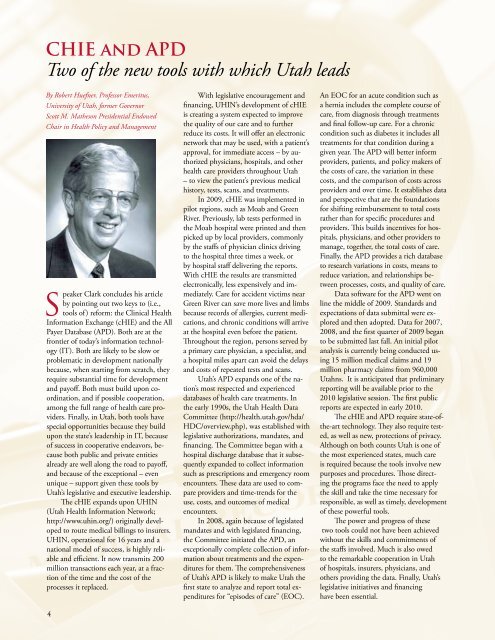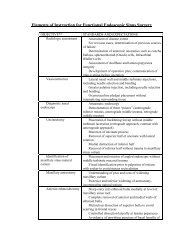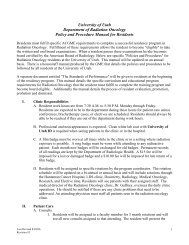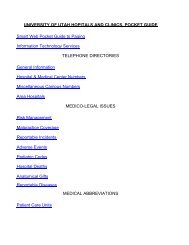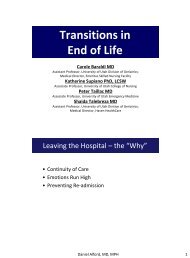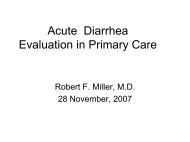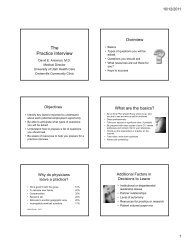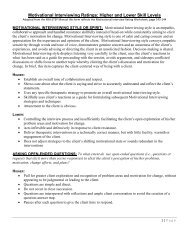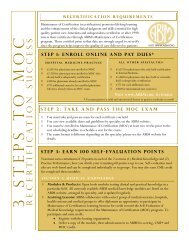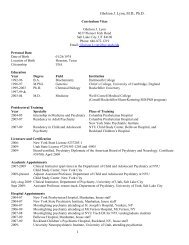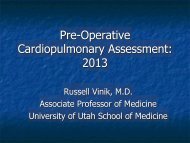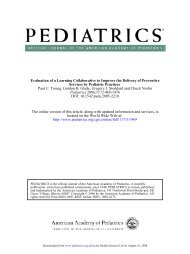Winter 2010 - University of Utah - School of Medicine
Winter 2010 - University of Utah - School of Medicine
Winter 2010 - University of Utah - School of Medicine
You also want an ePaper? Increase the reach of your titles
YUMPU automatically turns print PDFs into web optimized ePapers that Google loves.
CHIE and APD<br />
Two <strong>of</strong> the new tools with which <strong>Utah</strong> leads<br />
By Robert Huefner, Pr<strong>of</strong>essor Emeritus,<br />
<strong>University</strong> <strong>of</strong> <strong>Utah</strong>, former Governor<br />
Scott M. Matheson Presidential Endowed<br />
Chair in Health Policy and Management<br />
S<br />
peaker Clark concludes his article<br />
by pointing out two keys to (i.e.,<br />
tools <strong>of</strong>) reform: the Clinical Health<br />
Information Exchange (cHIE) and the All<br />
Payer Database (APD). Both are at the<br />
frontier <strong>of</strong> today’s information technology<br />
(IT). Both are likely to be slow or<br />
problematic in development nationally<br />
because, when starting from scratch, they<br />
require substantial time for development<br />
and pay<strong>of</strong>f. Both must build upon coordination,<br />
and if possible cooperation,<br />
among the full range <strong>of</strong> health care providers.<br />
Finally, in <strong>Utah</strong>, both tools have<br />
special opportunities because they build<br />
upon the state’s leadership in IT, because<br />
<strong>of</strong> success in cooperative endeavors, because<br />
both public and private entities<br />
already are well along the road to pay<strong>of</strong>f,<br />
and because <strong>of</strong> the exceptional – even<br />
unique – support given these tools by<br />
<strong>Utah</strong>’s legislative and executive leadership.<br />
The cHIE expands upon UHIN<br />
(<strong>Utah</strong> Health Information Network;<br />
http://www.uhin.org/) originally developed<br />
to route medical billings to insurers.<br />
UHIN, operational for 16 years and a<br />
national model <strong>of</strong> success, is highly reliable<br />
and efficient. It now transmits 200<br />
million transactions each year, at a frac-<br />
tion <strong>of</strong> the time and the cost <strong>of</strong> the<br />
processes it replaced.<br />
4<br />
With legislative encouragement and<br />
financing, UHIN’s development <strong>of</strong> cHIE<br />
is creating a system expected to improve<br />
the quality <strong>of</strong> our care and to further<br />
reduce its costs. It will <strong>of</strong>fer an electronic<br />
network that may be used, with a patient’s<br />
approval, for immediate access – by authorized<br />
physicians, hospitals, and other<br />
health care providers throughout <strong>Utah</strong><br />
– to view the patient’s previous medical<br />
history, tests, scans, and treatments.<br />
In 2009, cHIE was implemented in<br />
pilot regions, such as Moab and Green<br />
River. Previously, lab tests performed in<br />
the Moab hospital were printed and then<br />
picked up by local providers, commonly<br />
by the staffs <strong>of</strong> physician clinics driving<br />
to the hospital three times a week, or<br />
by hospital staff delivering the reports.<br />
With cHIE the results are transmitted<br />
electronically, less expensively and immediately.<br />
Care for accident victims near<br />
Green River can save more lives and limbs<br />
because records <strong>of</strong> allergies, current medications,<br />
and chronic conditions will arrive<br />
at the hospital even before the patient.<br />
Throughout the region, persons served by<br />
a primary care physician, a specialist, and<br />
a hospital miles apart can avoid the delays<br />
and costs <strong>of</strong> repeated tests and scans.<br />
<strong>Utah</strong>’s APD expands one <strong>of</strong> the nation’s<br />
most respected and experienced<br />
databases <strong>of</strong> health care treatments. In<br />
the early 1990s, the <strong>Utah</strong> Health Data<br />
Committee (http://health.utah.gov/hda/<br />
HDC/overview.php), was established with<br />
legislative authorizations, mandates, and<br />
financing. The Committee began with a<br />
hospital discharge database that it subsequently<br />
expanded to collect information<br />
such as prescriptions and emergency room<br />
encounters. These data are used to compare<br />
providers and time-trends for the<br />
use, costs, and outcomes <strong>of</strong> medical<br />
encounters.<br />
In 2008, again because <strong>of</strong> legislated<br />
mandates and with legislated financing,<br />
the Committee initiated the APD, an<br />
exceptionally complete collection <strong>of</strong> information<br />
about treatments and the expenditures<br />
for them. The comprehensiveness<br />
<strong>of</strong> <strong>Utah</strong>’s APD is likely to make <strong>Utah</strong> the<br />
first state to analyze and report total expenditures<br />
for “episodes <strong>of</strong> care” (EOC).<br />
An EOC for an acute condition such as<br />
a hernia includes the complete course <strong>of</strong><br />
care, from diagnosis through treatments<br />
and final follow-up care. For a chronic<br />
condition such as diabetes it includes all<br />
treatments for that condition during a<br />
given year. The APD will better inform<br />
providers, patients, and policy makers <strong>of</strong><br />
the costs <strong>of</strong> care, the variation in these<br />
costs, and the comparison <strong>of</strong> costs across<br />
providers and over time. It establishes data<br />
and perspective that are the foundations<br />
for shifting reimbursement to total costs<br />
rather than for specific procedures and<br />
providers. This builds incentives for hospitals,<br />
physicians, and other providers to<br />
manage, together, the total costs <strong>of</strong> care.<br />
Finally, the APD provides a rich database<br />
to research variations in costs, means to<br />
reduce variation, and relationships between<br />
processes, costs, and quality <strong>of</strong> care.<br />
Data s<strong>of</strong>tware for the APD went on<br />
line the middle <strong>of</strong> 2009. Standards and<br />
expectations <strong>of</strong> data submittal were explored<br />
and then adopted. Data for 2007,<br />
2008, and the first quarter <strong>of</strong> 2009 began<br />
to be submitted last fall. An initial pilot<br />
analysis is currently being conducted using<br />
15 million medical claims and 19<br />
million pharmacy claims from 960,000<br />
<strong>Utah</strong>ns. It is anticipated that preliminary<br />
reporting will be available prior to the<br />
<strong>2010</strong> legislative session. The first public<br />
reports are expected in early <strong>2010</strong>.<br />
The cHIE and APD require state-<strong>of</strong>the-art<br />
technology. They also require tested,<br />
as well as new, protections <strong>of</strong> privacy.<br />
Although on both counts <strong>Utah</strong> is one <strong>of</strong><br />
the most experienced states, much care<br />
is required because the tools involve new<br />
purposes and procedures. Those directing<br />
the programs face the need to apply<br />
the skill and take the time necessary for<br />
responsible, as well as timely, development<br />
<strong>of</strong> these powerful tools.<br />
The power and progress <strong>of</strong> these<br />
two tools could not have been achieved<br />
without the skills and commitments <strong>of</strong><br />
the staffs involved. Much is also owed<br />
to the remarkable cooperation in <strong>Utah</strong><br />
<strong>of</strong> hospitals, insurers, physicians, and<br />
others providing the data. Finally, <strong>Utah</strong>’s<br />
legislative initiatives and financing<br />
have been essential.


